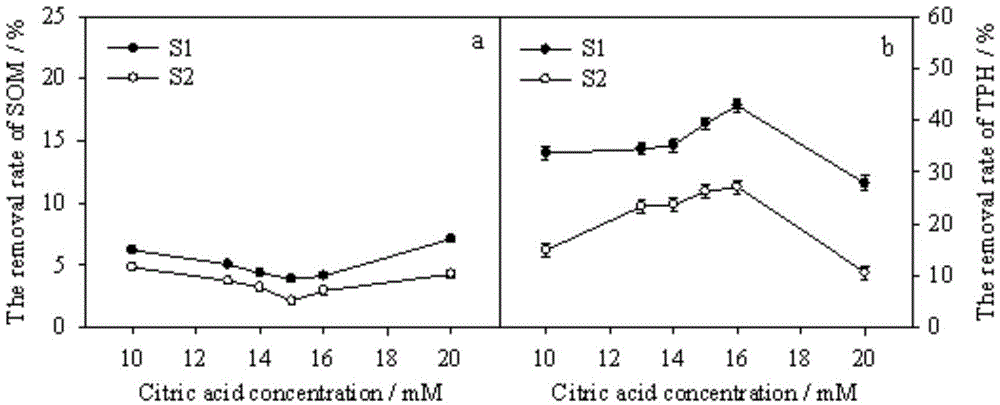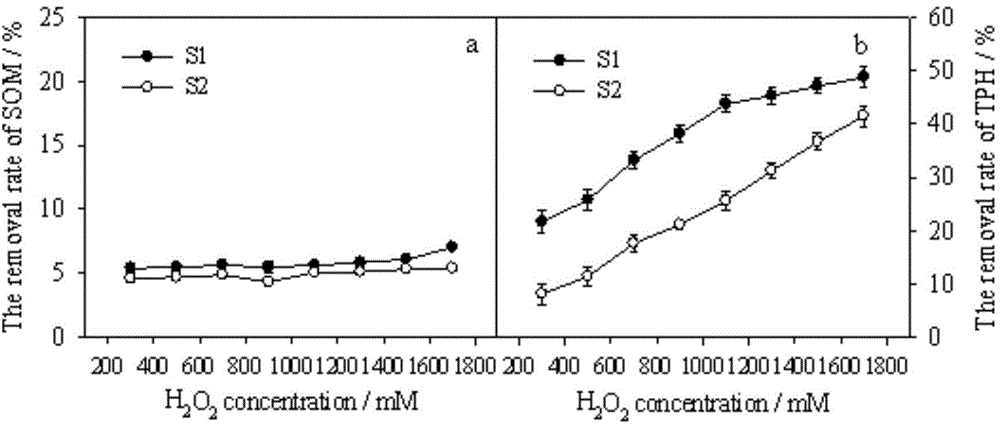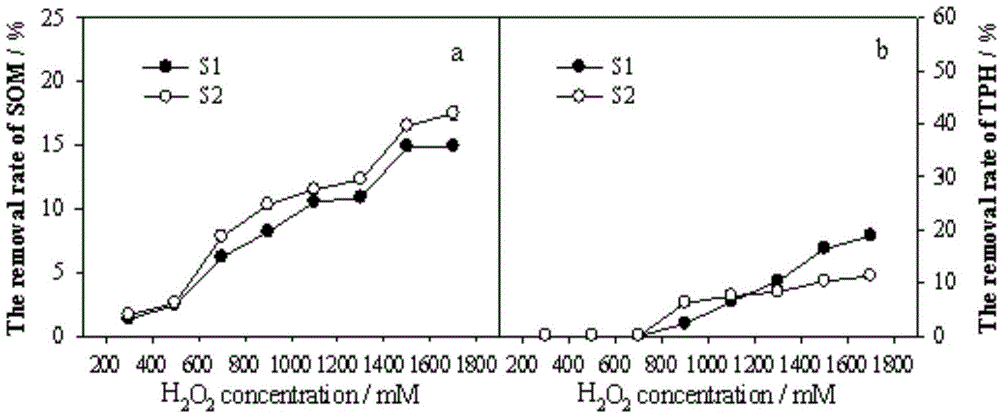Selective degradation method for petroleum pollutants in soil rich in organic matters
A selective, PetroChina technology, applied in the field of oil pollution remediation, can solve problems such as limited application, waste of chemicals, serious remediation of soil rich in organic matter, etc., and achieve the effect of improving removal rate, reducing oxidation, improving stability and utilization rate
- Summary
- Abstract
- Description
- Claims
- Application Information
AI Technical Summary
Problems solved by technology
Method used
Image
Examples
Embodiment 1
[0050] This embodiment provides a kind of selective degradation method of petroleum pollutants in soil rich in organic matter, comprising the following steps:
[0051] Step 1, citric acid-FeSO 4 Solution preparation:
[0052] Weigh ferrous sulfate (FeSO 4 ·7H 2 O), citric acid (C 6 h 8 o 7 ), anhydrous calcium chloride (CaCl 2 ), after adding water to dissolve, adjust the pH value to 9.0 with 5M NaOH to prepare a series of solutions;
[0053] The mass ratio of citric acid to calcium chloride anhydrous is 17.4:1.11;
[0054] Control the concentration of ferrous sulfate to 5.8mM, prepare a series of citric acid concentrations, so that the citric acid concentrations are 10mM, 13mM, 14mM, 15mM, 16mM, 20mM;
[0055] Step 2, carry out Fenton oxidation:
[0056] In the 100mL reaction bottle, first add 5g soil sample (S1 and S2 parallel test) and the concentration ratio of citric acid-FeSO4 in a series of steps one 4 solution, and then add a concentration of 900mM H 2 o 2 ...
Embodiment 2
[0062] This embodiment provides a kind of selective degradation method of petroleum pollutants in soil rich in organic matter, comprising the following steps:
[0063] Step 1, citric acid-FeSO 4 Solution preparation:
[0064] Weigh ferrous sulfate (FeSO 4 ·7H 2 O), citric acid (C 6 h 8 o 7 ), anhydrous calcium chloride (CaCl 2 ), after adding water to dissolve, adjust the pH value to 9.0 with 5M NaOH to prepare a series of solutions;
[0065] The mass ratio of citric acid to calcium chloride anhydrous is 17.4:1.11;
[0066] Control the concentration of ferrous sulfate to be 5.8mM, and control the concentration of citric acid to be 15mM respectively;
[0067] Step 2, carry out Fenton oxidation:
[0068] In the 100mL reaction flask, add 5g soil sample (S1 and S2 parallel test) and the citric acid-FeSO4 concentration ratio in step 1 4 solution, and then add a series of concentrations of H 2 o 2 , H 2 o 2 Concentrations were 300mM, 500mM, 700mM, 900mM, 1100mM, 1300mM...
Embodiment 3
[0080] This embodiment provides a kind of selective degradation method of petroleum pollutants in soil rich in organic matter, comprising the following steps:
[0081] Step 1, citric acid-FeSO 4 Solution preparation:
[0082] Weigh ferrous sulfate (FeSO 4 ·7H 2 O), citric acid (C 6 h 8 o 7 ), anhydrous calcium chloride (CaCl 2 ), after adding water to dissolve, adjust the pH value to 9.0 with 5M NaOH to prepare a series of solutions;
[0083] The mass ratio of citric acid to calcium chloride anhydrous is 17.4:1.11;
[0084] Control the concentration of ferrous sulfate to be 5.8mM, and control the concentration of citric acid to be 15mM respectively;
[0085] Step 2, carry out Fenton oxidation:
[0086] In the 100mL reaction flask, add 5g soil sample (S1 and S2 parallel test) and the citric acid-FeSO4 concentration ratio in step 1 4 solution, and then add a series of concentrations of H 2 o 2 , H 2 o 2 The concentration is 900mM, making FeSO 4 with H 2 o 2 The ...
PUM
 Login to View More
Login to View More Abstract
Description
Claims
Application Information
 Login to View More
Login to View More - R&D
- Intellectual Property
- Life Sciences
- Materials
- Tech Scout
- Unparalleled Data Quality
- Higher Quality Content
- 60% Fewer Hallucinations
Browse by: Latest US Patents, China's latest patents, Technical Efficacy Thesaurus, Application Domain, Technology Topic, Popular Technical Reports.
© 2025 PatSnap. All rights reserved.Legal|Privacy policy|Modern Slavery Act Transparency Statement|Sitemap|About US| Contact US: help@patsnap.com



